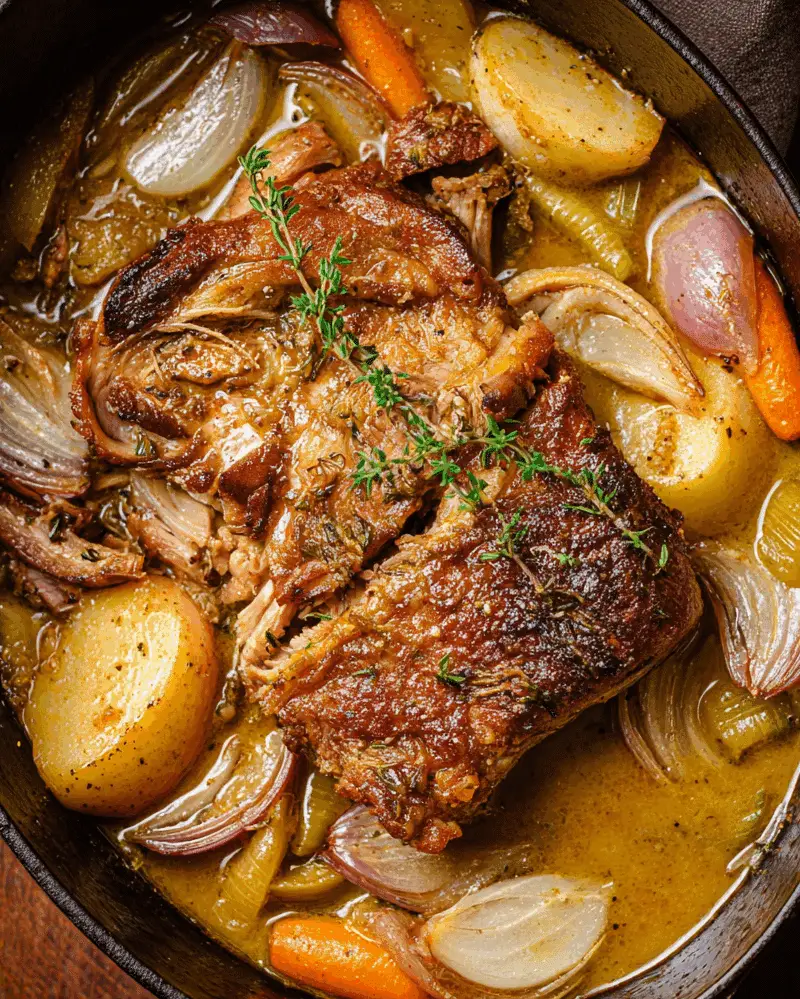Give me more information about this recipe, I will add it on my website article, more
than 1000 words with conclusion, do not include the ingredients breakdown and step by
step instructions. Don’t give me a link, I can’t access it. Bold all the headers and make it
heading 3. Don’t put lines between topics.
Full Recipe
Ingredients:
-
3.5 to 4 lbs boneless pork shoulder, trimmed
-
Kosher salt and freshly cracked black pepper
-
2 tablespoons olive oil
-
1 yellow onion, sliced
-
4 cloves garlic, smashed
-
2 carrots, chopped
-
2 ribs celery, chopped
-
2 cups apple cider (not apple cider vinegar)
-
1 cup chicken broth
-
2 tablespoons Dijon mustard
-
1 tablespoon apple cider vinegar
-
2 sprigs fresh rosemary
-
4 sprigs fresh thyme
-
2 bay leaves
Directions:
-
Preheat the oven to 300°F (150°C).
-
Generously season the pork shoulder with salt and pepper on all sides.
-
Heat olive oil in a large Dutch oven over medium-high heat. Sear the pork shoulder on all sides until browned (about 4–5 minutes per side). Transfer to a plate.
-
In the same pot, add onion, garlic, carrots, and celery. Sauté for 5–6 minutes until softened and fragrant.
-
Stir in the Dijon mustard and cook for 1 more minute.
-
Add apple cider, chicken broth, and apple cider vinegar. Stir to combine, scraping up any browned bits from the bottom.
-
Return the pork shoulder to the pot. Add rosemary, thyme, and bay leaves.
-
Bring the mixture to a simmer, then cover with lid and transfer to the oven.
-
Braise for 3.5 to 4 hours, until the pork is fork-tender and falling apart.
-
Remove the pork to a cutting board and let rest. Strain the liquid, discarding solids, and simmer the sauce to reduce slightly, if desired.
-
Shred the pork and return to the sauce or serve with it on the side.
Prep Time: 20 minutes | Cooking Time: 4 hours | Total Time: 4 hours 20 minutes
Kcal: 412 kcal | Servings: 6 servings
Introduction to Apple Cider Braised Pork Shoulder
Apple Cider Braised Pork Shoulder is the embodiment of slow-cooked comfort food—rustic, deeply flavorful, and perfect for fall and winter. This dish has roots in both traditional European braising techniques and American seasonal cooking, particularly in the Northeast, where apple cider is a cherished fall staple. The slow braising process results in incredibly tender, pull-apart pork infused with the subtle sweetness of apple cider, the depth of Dijon mustard, and the woodsy earthiness of fresh herbs like rosemary and thyme.
This recipe has gained popularity not just for its bold flavors, but also for how forgiving it is. You can prepare it in advance, let it cook low and slow while you go about your day, and enjoy an effortlessly impressive meal later. Whether you’re entertaining guests, preparing a Sunday dinner, or just craving something hearty and nostalgic, this dish hits all the right notes.
Why Braising Works So Well
Braising is a method of cooking that combines both dry and moist heat. The meat is first seared at high temperatures to develop flavor through the Maillard reaction, then slowly cooked in a flavorful liquid—here, apple cider and broth—at a low temperature. This dual approach transforms tougher cuts like pork shoulder into melt-in-your-mouth tender meat.
The apple cider not only helps to tenderize the pork but also contributes a gentle sweetness and acidity that balances the savory richness of the meat. The aromatics—onion, garlic, carrots, and celery—add layers of depth and complexity to the braising liquid, which reduces into a luxurious sauce by the end of cooking.
The Role of Apple Cider in the Recipe
Apple cider is the centerpiece of this dish, acting as both a flavor enhancer and a tenderizer. It’s important to note that this recipe calls for traditional apple cider—not the alcoholic hard cider and not apple cider vinegar. The natural sugars and fruitiness of cider break down during the long cooking process, intensifying in sweetness and caramel notes that complement the pork perfectly.
Using apple cider as a braising liquid also adds a seasonal twist, making this dish ideal for autumn menus. It pairs especially well with other fall ingredients like root vegetables, apples, and even squash. The cider provides a comforting familiarity, reminding many of apple orchards, crisp weather, and holiday gatherings.
Building Flavor With Aromatics and Herbs
One of the defining features of a well-braised dish is the use of aromatics and herbs to infuse the meat and sauce with flavor. In this recipe, onion and garlic serve as the flavor base, with carrots and celery adding natural sweetness and earthiness. These ingredients are sautéed before adding the liquid, allowing them to release their oils and intensify in flavor.
Fresh herbs like rosemary and thyme are added to the braising pot to introduce fragrant, piney notes that elevate the dish from simple to sophisticated. Bay leaves lend subtle background bitterness, helping to balance the sweetness of the cider. Dijon mustard introduces a mild tang and depth, acting as a bridge between sweet and savory components.
Texture and Tenderness: The Magic of Pork Shoulder
Pork shoulder, also known as pork butt or Boston butt, is a well-marbled cut that becomes incredibly tender when cooked slowly. Unlike leaner cuts that can dry out, pork shoulder benefits from long, gentle cooking times that allow the connective tissues and fats to break down.
After several hours of braising, the meat becomes so tender that it can be shredded effortlessly with a fork. It absorbs all the rich, complex flavors of the braising liquid, making every bite juicy and satisfying. This texture makes it perfect not just as a main dish, but also for repurposing leftovers in sandwiches, tacos, or even pasta dishes.
Serving Suggestions
This braised pork shoulder is versatile when it comes to serving options. For a classic presentation, pair it with creamy mashed potatoes or a buttery root vegetable mash to soak up the rich sauce. For something lighter, serve it over polenta, roasted cauliflower purée, or even a simple bed of wilted greens.
A crusty bread like sourdough or a rustic baguette is ideal for sopping up the juices. If you’re planning a holiday meal or Sunday dinner, consider pairing it with seasonal sides like roasted Brussels sprouts, baked acorn squash, or a warm apple slaw. The slight sweetness of the pork complements tangy, crunchy sides beautifully.
Storage and Reheating Tips
Apple Cider Braised Pork Shoulder stores exceptionally well, making it a great make-ahead or meal-prep option. Once cooked, allow the pork to cool completely before transferring it to an airtight container. It can be refrigerated for up to 4 days or frozen for up to 3 months.
To reheat, place the pork in a covered dish with some of the reserved braising liquid and warm it in a 300°F (150°C) oven until heated through. This helps to keep the pork moist and flavorful. Alternatively, reheat gently on the stovetop over low heat.
Leftover pork can be used in countless ways: piled onto sandwiches with pickled onions, added to tacos with avocado and slaw, stirred into risotto, or used as a protein topping for grain bowls.
Why This Dish Is Perfect for Entertaining
This recipe is a host’s best friend. It requires minimal hands-on time after the initial prep and gets better as it rests. That means you can spend more time with your guests and less time in the kitchen. The flavors are crowd-pleasers, and the presentation—whether served whole and carved at the table or shredded and sauced—has rustic charm and warmth.
It also scales easily. You can double the recipe in a large Dutch oven for a bigger crowd, or portion it down for an intimate dinner. Plus, the aroma that fills your home while it braises will have your guests salivating before the meal even begins.
Wine and Beverage Pairings
This dish pairs beautifully with a variety of drinks. For wine lovers, go for a medium-bodied red like Pinot Noir or a fruit-forward Zinfandel. Both have enough structure to match the richness of the pork while highlighting the sweet and savory balance of the dish.
If you’re sticking with the cider theme, a dry hard cider or a spiced apple cider cocktail would be a wonderful pairing. For non-alcoholic options, a spiced herbal tea or a sparkling apple beverage offers seasonal charm and balance.
Cultural and Seasonal Significance
Braised meats have long been a staple in many cultures, from French pot-au-feu to Italian stracotto and American pot roast. This particular rendition leans heavily into the fall season, embracing apple cider as a quintessential symbol of harvest time. Its flavors align well with holiday tables, making it a wonderful addition to Thanksgiving, Christmas, or even New Year’s Eve menus.
It’s also a reflection of sustainable cooking—taking a tough, inexpensive cut and transforming it into something luxurious and memorable with time and care. These kinds of dishes connect us to tradition, patience, and the joy of communal eating.
Conclusion
Apple Cider Braised Pork Shoulder is more than just a recipe—it’s a seasonal celebration of comfort, flavor, and tradition. From the aromatic blend of herbs and vegetables to the sweet, slow-cooked richness of apple cider, every component of this dish works in harmony to create a meal that’s both elegant and satisfying.
Whether you’re cooking for family, hosting a dinner party, or simply treating yourself to a hearty homemade dish, this pork shoulder delivers on all fronts. It’s proof that with just a few humble ingredients and some patience, you can create something truly special that warms both the body and soul.
If you’re looking to elevate your fall and winter dinners, add this braised pork to your rotation. It’s guaranteed to become a favorite you’ll come back to year after year.








